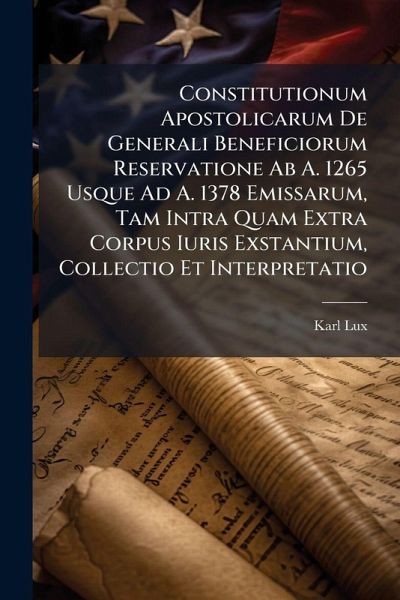
Constitutionum Apostolicarum De Generali Beneficiorum Reservatione Ab A. 1265 Usque Ad A. 1378 Emissarum, Tam Intra Quam Extra Corpus Iuris Exstantium, Collectio Et Interpretatio

PAYBACK Punkte
9 °P sammeln!
Constitutionum Apostolicarum De Generali Beneficiorum Reservatione Ab A. 1265 Usque Ad A. 1378 Emissarum, Tam Intra Quam Extra Corpus Iuris Exstantium, Collectio Et Interpretatio, by Karl Lux, is a comprehensive collection and interpretation of Apostolic Constitutions concerning the general reservation of benefices from the year 1265 to 1378. This work compiles documents both within and outside the body of law, drawing upon materials from the Vatican archives and the Barberini Library. It provides a detailed examination of papal decrees related to ecclesiastical benefices during a crucial peri...
Constitutionum Apostolicarum De Generali Beneficiorum Reservatione Ab A. 1265 Usque Ad A. 1378 Emissarum, Tam Intra Quam Extra Corpus Iuris Exstantium, Collectio Et Interpretatio, by Karl Lux, is a comprehensive collection and interpretation of Apostolic Constitutions concerning the general reservation of benefices from the year 1265 to 1378. This work compiles documents both within and outside the body of law, drawing upon materials from the Vatican archives and the Barberini Library. It provides a detailed examination of papal decrees related to ecclesiastical benefices during a crucial period in Church history. Of particular interest to legal historians, canon lawyers, and scholars of medieval history, this volume offers invaluable insight into the development of canon law and the administration of Church properties and privileges during the late Middle Ages. This work has been selected by scholars as being culturally important, and is part of the knowledge base of civilization as we know it. This work was reproduced from the original artifact, and remains as true to the original work as possible. Therefore, you will see the original copyright references, library stamps (as most of these works have been housed in our most important libraries around the world), and other notations in the work. This work is in the public domain in the United States of America, and possibly other nations. Within the United States, you may freely copy and distribute this work, as no entity (individual or corporate) has a copyright on the body of the work. As a reproduction of a historical artifact, this work may contain missing or blurred pages, poor pictures, errant marks, etc. Scholars believe, and we concur, that this work is important enough to be preserved, reproduced, and made generally available to the public. We appreciate your support of the preservation process, and thank you for being an important part of keeping this knowledge alive and relevant.


